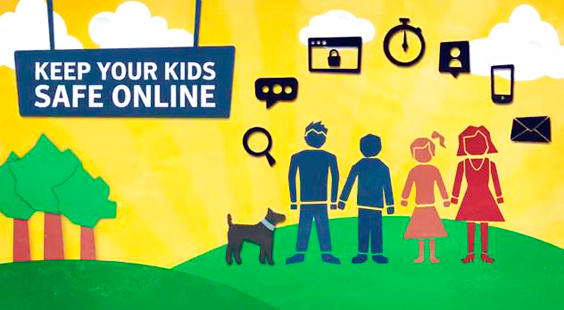How To Protect Kids From Online Scams
Helping Kids Spot And Avoid Online Scams

Do your kids follow influencers? They probably do – it’s normal for kids to follow trends and the people who make them. However, not everybody online is who they say they are, and not everybody online is honest. That was a lesson Emma had to learn the hard way.
A typical California teenager, Emma received a message on Instagram from someone who appeared to be a popular influencer she followed. The account had a similar profile picture, bio, and verified checkmark – everything seemed real. She was excited when the influencer told her she had been selected for a unique opportunity to collaborate on a sponsored post.
All she had to do was share a brand’s products on her profile… and pay a small “registration fee” first. The scammer promised Emma the fee would be refunded once the collaboration began. So Emma followed the instructions, paying $200 through a gift card. And that’s when the “influencer” stopped responding.
Emma had been scammed. When her parents noticed something was wrong, they learned Emma could no longer contact the influencer. They discovered the Instagram profile was fake. The family reported the incident to Instagram, but the scammer had already taken the money.
I don’t want to sound like an alarmist, but scams are everywhere. The FTC reported $10 billion lost to scams in 2023… and that was just from the people who admitted to being scammed. Today’s scammers are trickier than they’ve ever been. They use sophisticated tactics and prey on peoples’ social behavior – and more often than not, they’re online.
That can be scary for us parents because, let’s face it, our kids are typically online a lot more frequently than we are! In fact, 65% of 8—to 10-year-olds use social media for at least four hours daily. So, how do we keep our kids safe from scams? The answer is educating our kids about how to spot scams and be smart online.
Understanding What Scams Are
At its simplest, a scam tricks someone into giving away money, personal information, or resources. Scammers prey on trust, curiosity, and sometimes fear to achieve their goals. They use tactics that can be surprisingly convincing, especially to kids who might not yet recognize the warning signs.
The Most Common Scams Kids Encounter
Scams targeting kids and teens often leverage their favorite platforms and hobbies. Online scams are prevalent, with many children encountering fake prize notifications or phishing messages asking for sensitive information. Scammers know how to make their messages look official, whether it’s an email from a “trusted” source or an in-app message in a game they love. In gaming environments, scammers might pose as fellow players or game developers offering exclusive items in exchange for money.
Phone scams, though slightly less frequent for kids, can still happen. These often involve calls or texts pretending to be from familiar organizations, such as a bank or government agency, urging immediate action. In-person scams might occur when a stranger offers a product or service that seems amazing but comes with hidden risks. Teaching kids to recognize these schemes prepares them to handle them safely.
Key Red Flags to Teach Your Kids
Spotting scams often involves noticing red flags. One common warning sign is when someone asks for money or personal information out of the blue. If a message or call claims they’ve won a prize but demand upfront fees, it’s a scam. Another major clue is urgency.

Scammers often try to create panic or pressure, pushing kids to act before they think. Messages with odd grammar or language can also signal something suspicious. Teaching kids to question messages or offers from unfamiliar sources is a vital habit that can save them from falling victim.
Teaching Kids How to Respond to Scams
Knowing how to react is just as important as recognizing a scam. Please encourage your child to step back and think before responding to any unexpected message, email, or call. Explain the importance of involving an adult whenever something feels off.
Make it clear that personal information, such as passwords or addresses, should never be shared without permission. Kids should also know how to block suspicious contacts and report scams to the appropriate platform or authority (in the US, that’s the FTC).
Practical Strategies for Preventing Scams
Prevention is key when it comes to scams. Start by teaching kids the basics of digital safety, like creating strong passwords and recognizing secure websites. Show them how oversharing personal details online can make them targets for scammers.
Keeping an eye on app and internet use can also go a long way. Scammers often disguise their schemes within apps or pop-ups that appear legitimate. Kids should know not to trust everything they see online and to think twice before interacting with unfamiliar accounts.
It’s also essential that you make sure your kids know that you’re a safe person to talk to about online interactions. Many of our kids’ worlds and social interactions are online, and the lines between cyberspace and the real world have blurred. Take their concerns seriously, and don’t fall into the trap of thinking that online interactions don’t have offline consequences. Younger kids should monitor their phones and online activity until they demonstrate they’re mature enough to make good online decisions.
Fun Ways to Teach Kids About Scams
Learning about scams doesn’t have to feel like a chore. Engaging kids with hands-on activities can make the lessons stick. Role-playing scenarios are a great way to practice responses to potential scams.
You can pretend to send a fake email or text and see how your child reacts, using it to discuss what they did well and what they could improve. Online quizzes or games focused on spotting scams can be fun, especially if you do them and challenge the kids to compete with you to see who’s better at spotting scams.
Beyond that, keeping the topic part of family conversations helps reinforce these lessons over time. It creates a safe space where kids feel comfortable bringing up anything suspicious.
Empowering Your Kids: Fostering Critical Thinking
The best defense against scams is curiosity and caution. Encourage your child to question things that don’t feel right. If something seems too good to be true, it probably is. Celebrate when your child spots a scam or takes the proper steps to protect themselves.
Positive reinforcement helps build confidence in navigating tricky situations. As scams evolve, an ongoing conversation about online safety ensures your child stays informed and prepared. Empowering kids to think critically protects them from scams and many other challenges they might face online.
What to Do if Your Child Falls for a Scam
If your child falls victim to a scam, staying calm is the most important first step. Assure them that anyone can be fooled and focus on acting quickly. If they’ve shared personal information, help them change passwords or notify the appropriate authorities.
Contact the payment provider or bank to recover the funds if money is involved. Also, make sure you report the scam to the FTC. Even if your child doesn’t fall for the scam, the FTC monitors and helps shut down scam attempts, keeping everyone safer.
While the situation may be stressful, it can also be a valuable learning experience. Use it to review what happened, identify the warning signs, and discuss how to avoid similar situations in the future.
Staying Safe in a World Full of Scams
Teaching kids about scams isn’t about making them fearful; it’s about giving them tools to stay safe and make wise decisions. Educating them early equips them to handle the challenges of living in a digital world. Encourage regular conversations about online safety and help your kids recognize scams when they encounter them. Please don’t keep this knowledge to yourself; share it with other parents to keep their kids safe. Together, we can help kids navigate the online world with confidence!
How do you help your kids stay safe online? What do you wish you knew more about scams? Let us know in the comments; this is an important discussion! For more tips on raising smart, educated kids, check out the Support for Stepdads blog.





